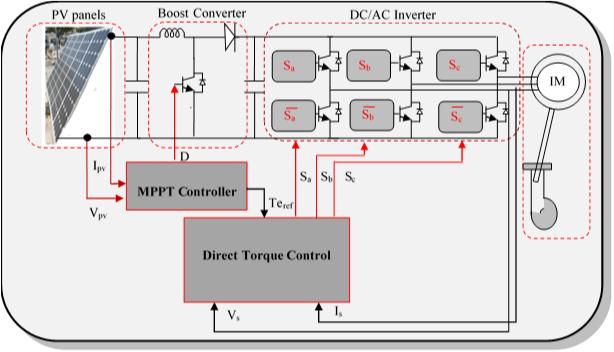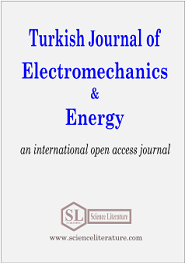
Direct torque control for autonomous photovoltaic system with MPPT control
Abstract
This work deals with the control of a photovoltaic pumping system. It is based on an induction motor, and direct torque control (DTC) is applied. The method adopted is based on the instantaneous space vector theory. By optimal selection of the space voltage vectors in each sampling period, DTC archives effective control of the stator flux and torque. The most important advantage of this method is its rotor position free control system. To improve photovoltaic (PV) system performances, Perturb & Observe maximum power point tracking (MPPT) algorithm has been used to achieve sufficient power to operate the water pumping system under variable conditions. Through this work, it is aimed to obtain a simple and low-cost system for the photovoltaic water pumping systems with rapid tracking of the maximum power. The proposed system with DTC and MPPT strategy not only improves system performance but also extends the working hours of solar photovoltaic systems. Simulation of the adopted method is also presented.
Full Text:
PDFReferences
S. O. Amrouche, D. Rekioua, T. Rekioua, Overview of energy storage in renewable energy systems, Proceedings of 2015 IEEE International Renewable and Sustainable Energy Conference, IRSEC 2015, art. no. 7454988, (2016).
D. Rekioua, E. Matagne, Optimization of Photovoltaic Power Systems, Modelization, Simulation and Control, Edition Springer, Green Energy and Technology, 102, (2012).
M. S. Ebrahim, A.M. Sharaf, A.M. Atallah, and A.S. Emarah, An Efficient Controller for Standalone Hybrid-PV Powered System, Turkish Journal of Electromechanics & Energy 2(1), 9-15, (2017).
M. A. Ramli, S. Twaha, K. Ishaque, A. YAl-Turki, A review on maximum power point tracking for photovoltaic systems with and without shading conditions’, Renewable and Sustainable Energy Reviews, 67, 144–159, (2017).
N. Karami, N. Moubayed, R. Outbib, General review, and classification of different MPPT Techniques, Renewable and Sustainable Energy Reviews, 68(1), 1-18, (2017).
A. R. Reisi, M. H. Moradi, S. Jamasb, Classification and comparison of maximum power point tracking techniques for photovoltaic system: a review, Renew. Sustainable Energy Rev. 19 (C), 433–443, (2013).
D. P. Hohm and M. E. Ropp, Comparative study of maximum power point tracking algorithms, Progress in Photovoltaics: Research and Applications, 11, 47-62, (2003).
V. Salas, E. Olias, A. Barrado, A. Lazaro, Review of The Maximum Power Point Tracking Algorithms for Stand-Alone Photovoltaic Systems, Solar Energy Materials & Sol. Cells, 90 (11), 1555–1578 (2006).
S. Necaibia, M. S. Kelaiaia, H. Labar, A. Necaibia, Implementation of an Improved Incremental Conductance MPPT Control Based Boost Converter in Photovoltaic Applications, International Journal of Emerging Electric Power Systems, 18 (4), 1-19, (2017).
R. Cakmak, I. H. Altas, A. M. Sharaf, Modeling of FLC-Incremental based MPPT using DC-DC boost converter for a standalone PV system, International Symposium on Innovations in Intelligent Systems and Applications, Trabzon, 1-5, (2012)
M. S. Ghayad, N. M. Badra, A. Y. Abdelaziz, A. M. Sharaf, M. A. Attia, A New efficient self-adjusting PSO algorithm to enhance reactive power response of VSC-HVDC system, Turkish Journal of Electromechanics & Energy, 5(1), 28-36, (2020).
S. Bensmail, D. Rekioua, H. Azzi, Study of hybrid photovoltaic/fuel cell system for stand-alone applications, International Journal of Hydrogen Energy, 40(39), 13820-13826, (2015).
M. R. Douiri, Particle swarm optimized neuro-fuzzy system for photovoltaic power forecasting model, Solar Energy, 91-104, (2019).
H. Hamdi, C.B. Regaya, A. Zaafouri, A sliding-neural network control of induction-motor-pump supplied by a photovoltaic generator, Protection and Control of Modern Power Systems, 5 (1), art. no. 1, (2020).
D. Rekioua, F. Zaouche, H. Hassani, T. Rekioua, S. Bacha, Modeling and fuzzy logic control of a stand-alone photovoltaic system with battery storage, Turkish Journal of Electromechanics & Energy, 4 (1), 11-17, (2019).
S. Abouda, F. Nolet, A. Chaari, N. Essoumbouli, Y. Koubaa, Direct Torque Control DTC of Induction Motor Used for Piloting a Centrifugal Pump Supplied by Photovoltaic Generator, International Journal of Electrical, Computer, and Communication Engineering, 7(8), 1110-1115, (2013).
T. Rekioua, D. Rekioua, Direct torque control strategy of permanent magnet synchronous machines 2003 IEEE Bologna PowerTech - Conference Proceedings, 2, art. no. 130466 , 861-866, (2003).
P. K. Behera, M. K. Behera, A. K. Sahoo, Comparative Analysis of Scalar & Vector Control of Induction Motor Through Modeling & Simulation, International Journal of Innovative Research, Electronics, Instrumentation, and Control Engineering, 2(4), 1340-1344, (2014).
Z. Mokrani, D. Rekioua, T. Rekioua, Control of Fuel Cells-Electric Vehicle Based on Direct Torque Control, Turkish Journal of Electromechanics & Energy, 3(2), 8-14, (2018).
S. J. Salehi, J. Siahbalaee, Loss minimization strategy under direct torque control method using matrix converter fed IPMS Motor, Journal of Electrical Engineering, 16 (2),135-143, (2016).
URN: https://sloi.org/urn:sl:tjoee52159
Copyright (c) 2020 Turkish Journal of Electromechanics and Energy

This work is licensed under a Creative Commons Attribution-NonCommercial 4.0 International License.

 Indexed in:
Indexed in:
















